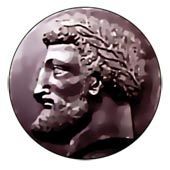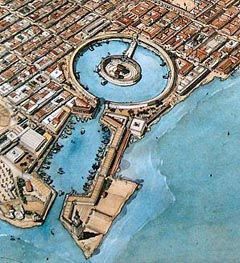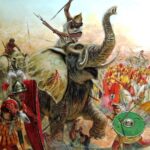Chapters
Third Punic War took place in 149-146 BCE and led to the final fall of the great enemy of the Romans – Carthage.
Background of events
After losing two Punic Wars, Carthaginians were militarily and economically weak. They did not have a permanent army and the internal situation was chaotic. As a result of the previous war, she lost her allies and had to pay back huge war reparations of 10,000 talents in silver (it was paid back as 200 talents per year, for 50 years).
The reconstruction of the Carthaginian economy began shortly after the end of hostilities in the Second Punic War, mainly thanks to Hannibal himself. However, the systematic development of the state was halted in the middle of the 2nd century BCE, when the ruler of Numidia, Masinissa, tried to develop his state creation at the expense of Carthage. He knew perfectly well that Carthage did not have the right to declare war alone, according to the Rome Treaty of 201 BCE. He hoped that by defeating Carthage he would establish his rule in North Africa and stop the expansion of Rome in this area. He wanted to create the capital of his future power from Carthage.
Carthage’s situation was tragic. It was known that the Roman Senate would not agree to warfare undertaken by the Carthaginian side. At the same time, if Carthage were not armed against the aggressor, it would have been conquered. However, the attack of Numidia in the territory of Carthage met with the opposition of the Carthaginian aristocracy, which forced the rulers to declare war against the provisions of the Carthaginian-Roman Agreement. The situation was taken advantage of by the influential circles of Roman politicians with the Marcus Porcius Cato, who sought to finally deal with Carthage. To this day, the famous words of Katon, a fervent hatred of Carthage, ceterum censeo Carthaginem esse delendam are remembered (“And besides, I think Carthage should be destroyed”). The Roman senator always ended his speech with these words, even if they did not apply to Carthage. Katon believed that the Romans would never have a sense of security and freedom until Carthage was destroyed. Publius Cornelius Scipio Nasica, who was against attacking and destroying Carthage, presented a completely different position.
In 151 BCE, Numidia carried out one of many assaults on Carthaginian territory and the besieged city of Oroscopa. The aristocracy decided to send a military expedition of 25,000 soldiers to reject the aggressors from the city walls. Unfortunately, however, the Punic army failed, and as a result Carthage was covered by another 50-year duty to pay Numidia’s debt.
It should also be noted that in 151 BCE Carthage repaid all war reparations, thus believing that it became independent of Rome and the treaty ending the Second Punic War expired. The Romans had a completely different approach, according to which the agreement was still in force, and Carthage was subordinated to the Republic and its allies. On the other hand, the fact that Carthage paid off its debt and did not have to send money to Rome anymore, only confirmed the Romans that the time of peace had passed. In addition, the still-developing capital of the Republic (in the middle of the 2nd century BCE it had a population of about 400,000 and continued to grow), it required a larger supply of grain and food.
In 149 BCE Rome declared war on Carthage. However, when they heard of this decision, the Punnians pledged to surrender one hundred well-born Carthaginian children as hostages to Rome in exchange for the right to their land and independent rule. Unexpectedly, one of the cities of Carthage – Utica went to the side of Rome, and a Roman army of 80,000 soldiers chose this place for their camp. Eventually, the consuls forced Carthage to surrender all the war equipment before passing the city’s death sentence. An ultimatum was presented to the Carthaginians, either they would leave the city and settle 15 km from the sea, or the city would be completely destroyed. The verdict was rejected by the Carthaginian authorities, which ordered the immediate strengthening of the capital.
War
It was decided to send two legions to Africa to eliminate Carthage. The badly commanded and poorly trained Roman army turned out to be totally unprepared to fight desperate inhabitants, as a result of which the campaign (called Tertium Bellum Punicum) began with a series of disasters. The main military expedition of consuls Manius Manilius and Lucius Marcius Censorinus stormed the capital from two sides. The attack was, however, repelled by Punnians led by Hasdrubal and Himilco Phameas. Manilius lost over 500 people when they were surprised by Carthaginian driving while collecting wood near Lake Tunis.
An even worse defeat was suffered by the Roman fleet, which burst into flames as a result of the skilful actions of the Punic fleet, which forced the Roman flamethrowers to set themselves against the wind. As a result of Manilius’s next defeat at Nepheris (fortress south of the capital), he was replaced by the consul Calpurnius Piso in 149 BCE, Scipio Aemilianus. He showed courage and clarity of mind, often saving his soldiers from death. His intervention saved four cohorts trapped in a ravine. In the meantime, in the fall of 148 BCE, Consul Piso was rejected from the city of Aspis (now Kelibia) and later also retreated from Hippagret – a city in the north (Bizert’s assessment). These events caused the Senate to dismiss him in 147 BCE and elect Scipio as consul (and then governor of Africa). In winter 147-146 BCE Scipio captured the fortress of Nepheris. Emilianus turned out to be the saviour of Rome, just like the Scipio African the Elder (his grandfather) in the Second Punic War.
As soon as Scipio was in Africa, he concentrated on training and raising army morale. He took good care of the army and all organizational matters. After minor skirmishes, he managed to reach Carthage, which he then besieged.
The Carthaginians successfully withstood the siege of Carthage from 149 to spring 146 BCE. The final assault of Scipio’s forces caused the legionaries to break behind the city walls, and despite the courage and sacrifice of the inhabitants, the city was conquered.
Consequences
As a result of hunger in the capital of Carthage, during the last months of the siege, many Carthaginians were killed. Carthage, on the order of the Roman Senate, was completely destroyed (demolition of the city lasted 17 days), and the land on which the city was cursed. The territory of the former state was transformed into a new province of Africa, and the inhabitants were displaced, murdered, and the remaining survivors (50,000) were sold into slavery. Carthage was annexed and transformed into the province of Africa according to the Roman system. Consul and winner Scypion Emilianus received the nickname “African”, like his grandfather, and to this day he is known as Scipio African Junior. Carthage’s name was tried to be erased from memory and history. One of Rome’s greatest rivals before our era has never been revived.
Major battles of the Third Punic War
149 BCE – battle of Nepheris
- Hasdrubal’s Carthaginians win the Manilius Romans
148 BCE – the siege of Hippagretta
147 BCE – naval battle at the Carthaginian port
147 BCE – second battle of Nepheris
146 BCE – the siege of Carthage
- the army of Publius Cornelius Scipio the Younger conquered the city and, in accordance with the Senate’s decision, destroyed Carthage











